1.21 Acids and Bases: The Lewis Definition
The Lewis definition of acids and bases is more encompassing than the Brønsted–Lowry definition because it’s not limited to substances that donate or accept just protons. A Lewis acid is a substance that accepts an electron pair, and a Lewis base is a substance that donates an electron pair. The donated electron pair is shared between the acid and the base in a covalent bond.
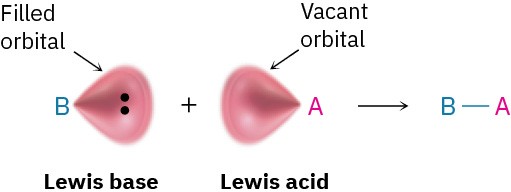
Lewis Acids and the Curved Arrow Formalism
The fact that a Lewis acid is able to accept an electron pair means that it must have either a vacant, low-energy orbital or a polar bond to hydrogen so that it can donate H+ (which has an empty 1s orbital). Thus, the Lewis definition of acidity includes many species in addition to H+. For example, various metal cations, such as Mg2+, are Lewis acids because they accept a pair of electrons when they form a bond to a base.
 In the same way, compounds of group 3A elements, such as BF3 and AlCl3, are Lewis acids because they have unfilled valence orbitals and can accept electron pairs from Lewis bases, as shown in Figure 1.23. Similarly, many transition-metal compounds, such as TiCl4, FeCl3, ZnCl2, and SnCl4, are Lewis acids.
In the same way, compounds of group 3A elements, such as BF3 and AlCl3, are Lewis acids because they have unfilled valence orbitals and can accept electron pairs from Lewis bases, as shown in Figure 1.23. Similarly, many transition-metal compounds, such as TiCl4, FeCl3, ZnCl2, and SnCl4, are Lewis acids.

Figure 1.23 The reaction of boron trifluoride, a Lewis acid, with dimethyl ether, a Lewis base. The Lewis acid accepts a pair of electrons, and the Lewis base donates a pair of nonbonding electrons. Note how the movement of electrons from the Lewis base to the Lewis acid is indicated by a curved arrow. Note also how, in electrostatic potential maps, the boron becomes more negative (red) after reaction because it has gained electrons and the oxygen atom becomes more positive (blue) because it has donated electrons.
Look closely at the acid–base reaction in Figure 1.23, and notice how it’s shown. Dimethyl ether, the Lewis base, donates an electron pair to a vacant valence orbital of the boron atom in BF3, a Lewis acid. The direction of electron-pair flow from base to acid is shown using a curved arrow, just as the direction of electron flow from one resonance structure to another was shown using curved arrows in Section 1.16. We’ll use this curved-arrow notation throughout the remainder of this text to indicate electron flow during reactions, so get used to seeing it.
Some further examples of Lewis acids follow:
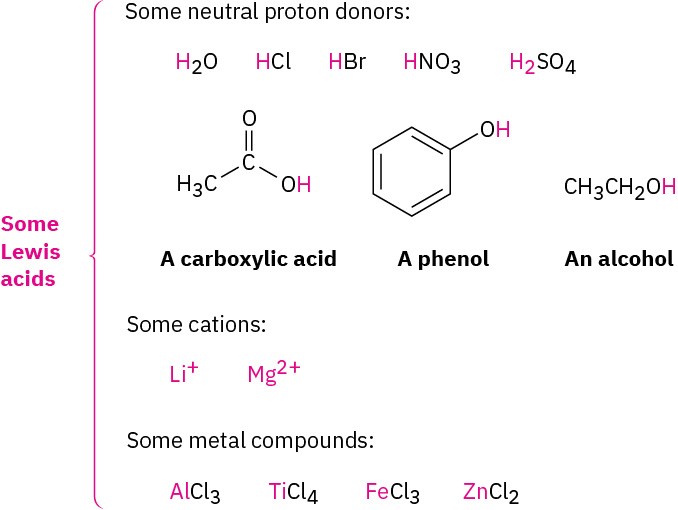
Lewis Bases
The Lewis definition of a base—a compound with a pair of nonbonding electrons that it can use to bond to a Lewis acid—is similar to the Brønsted–Lowry definition. Thus, H2O, with its two pairs of nonbonding electrons on oxygen, acts as a Lewis base by donating an electron pair to an H+ in forming the hydronium ion, H3O+.
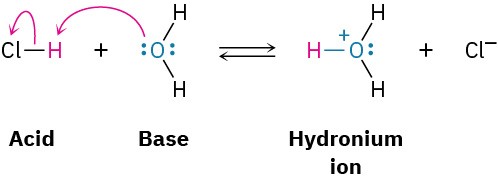 In a more general sense, most oxygen- and nitrogen-containing organic compounds can act as Lewis bases because they have lone pairs of electrons. A divalent oxygen compound has two lone pairs of electrons, and a trivalent nitrogen compound has one lone pair. Note in the following examples that some compounds can act as both acids and bases, just as water can. Alcohols and carboxylic acids, for instance, act as acids when they donate an H+ but as bases when their oxygen atom accepts an H+.
In a more general sense, most oxygen- and nitrogen-containing organic compounds can act as Lewis bases because they have lone pairs of electrons. A divalent oxygen compound has two lone pairs of electrons, and a trivalent nitrogen compound has one lone pair. Note in the following examples that some compounds can act as both acids and bases, just as water can. Alcohols and carboxylic acids, for instance, act as acids when they donate an H+ but as bases when their oxygen atom accepts an H+.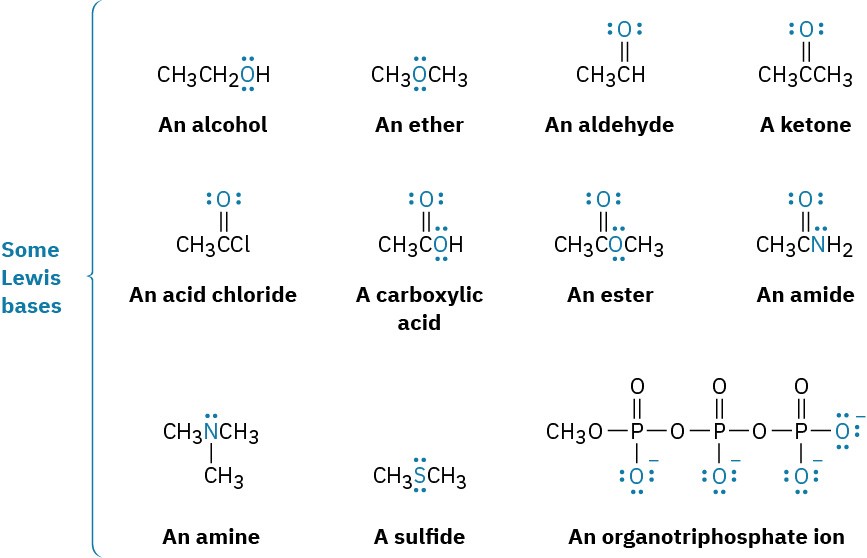 Note also that some Lewis bases, such as carboxylic acids, esters, and amides, have more than one atom with a lone pair of electrons and can therefore react at more than one site. Acetic acid, for example, can be protonated either on the doubly bonded oxygen atom or on the singly bonded oxygen atom. Reaction normally occurs only once in such instances, and the more stable of the two possible protonation products is formed. For acetic acid, protonation by reaction with sulfuric acid occurs on the doubly bonded oxygen because that product is stabilized by two resonance forms.
Note also that some Lewis bases, such as carboxylic acids, esters, and amides, have more than one atom with a lone pair of electrons and can therefore react at more than one site. Acetic acid, for example, can be protonated either on the doubly bonded oxygen atom or on the singly bonded oxygen atom. Reaction normally occurs only once in such instances, and the more stable of the two possible protonation products is formed. For acetic acid, protonation by reaction with sulfuric acid occurs on the doubly bonded oxygen because that product is stabilized by two resonance forms.
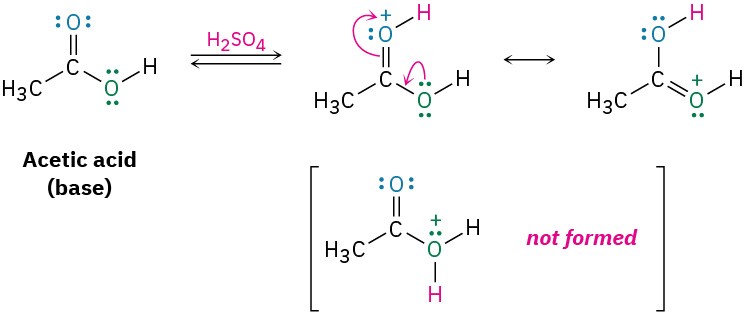
Worked Example 1.7: Using Curved Arrows to Show Electron Flow
Using curved arrows, show how acetaldehyde, CH3CHO, can act as a Lewis base.
Strategy
A Lewis base donates an electron pair to a Lewis acid. We therefore need to locate the electron lone pairs on acetaldehyde and use a curved arrow to show the movement of a pair toward the H atom of the acid.
Solution

Problem 1.29
Using curved arrows, show how the species in part (a) can act as Lewis bases in their reactions with HCl, and show how the species in part (b) can act as Lewis acids in their reaction with OH–.
(a) CH3CH2OH, HN(CH3)2, P(CH3)3
(b) H3C+, B(CH3)3, MgBr2

